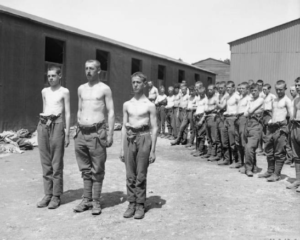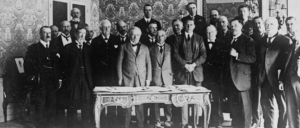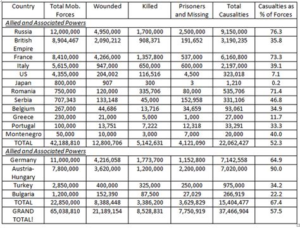While the meaning of the Great War has changed over time, it is possible after 100 years to take a more balanced view. It is becoming accepted that the Great War was not a ‘bad’ or ‘unjust’ war, at least from an Allied point of view. It was fought against military aggression and to protect the sovereignty of small states, as well as the integrity of British power. The war had a powerful democratising affect, with people who fought it, demanding a new place in society for the ordinary citizen. The Britain we’ve inherited today and it’s citizen democracy grew out the sacrifice of World War 1. What went wrong was the bad peace that followed WW1. We can now remember the scale of sacrifices made at the time, the moving stories of the “Pals’ regiments, the horrors of battles, such as Gallipoli, the Somme, and Passchendaele, without allowing any doubts about the justice of the war, preventing our respect for the fallen.

The legacy of the Great War still has an enduring resonance. While the War helped postpone domestic strife and unite the United Kingdom between 1914-18, the war made Britain very wary about intervening in Europe again. Britain is still divided whether it should be part of Europe today.
The Great war was not the war to end all wars. The new world order after the war widened the world and made politics international, fuelling more global tensions, conflict, rebellions and uprisings throughout the 1920’s. Civil wars soon broke out in Ireland, the Balkans, and Russian States. The creation of new territories in the Middle East, such as Arabia, Iraq, Syria, Lebanon and Palestine, sparked resistance movements to challenge European dominance. Many of the current problems in the Middle East can be directly traced to the boundaries and territories that were drawn up directly after the First World War. The War forced America to emerge from isolation, and become the World Superpower which dominates today.
The War replaced old Empires and military autocracies with new democratic Nation States. Government’s expanded their powers and responsibilities to win the war and we all now accept greater state intervention, in terms of managing our health, welfare and taxation. Women achieved the vote and more political rights through the First World War. The War generated a quantum leap in industry, technology, medicine, culture and international politics. After World War One, Revolution, Republicanism and Fascism flourished. Old Empires fell apart and gave rise to mass democracy. People rose up and three visions emerged to harness ‘people power’. These were Bolshevism and the one Party State, Liberty and Republicanism, with no place for monarchs and aristocrats, and Fascism, with the cult of the Great Leader. These ideologies which emerged from the First World war, dominated the Twentieth Century and still shape ideas today. It is for these reasons that the First World War will always be remembered.

The Lost Generation
This term is used for the generation of young people who came of age at around the time of WW1 and died in the war.
Authors William Strauss and Neil Howe define the Lost Generation as the cohort born from 1883 to 1900, who came of age during World War I and the “Roaring Twenties”.
In America, Gertrude Stein coined the phrase the “Lost Generation”. This was popularised by Ernest Hemmingway in his 1926 novel “The Sun Also Rises” and refers to the “disoriented, wandering, directionless” spirit of many of the war’s survivors in the early post war period.
In Europe, they are mostly known as the “Generation of 1914”, for the year World War I began. In France they were sometimes called the Génération du feu, the “(Gun)fire Generation”.
In Great Britain, the term was originally used for those who died in the war, and often implicitly referred to upper-class casualties who were perceived to have died disproportionately, robbing the country of a future elite. Many felt that “the flower of youth and the best manhood of the peoples [had] been mowed down,” for example such notable casualties. as the poets Isaac Rosenberg, Rupert Brooke, Edward Thomas and Wilfred Owen, composer George Butterworth and physicist Henry Moseley” While the majority of men returned from the war, the myth of the “Lost generation” endured. Britain certainly lost a large number of high achievers during the war and some families in a short space of time, lost all sons, heirs and breadwinners. In cities like Hull, over a hundred families lost two or more men from the same family. At least ten Hull families, lost three sons and four Hull families are known to have lost four sons.
Young men of the cohort, born from 1883 to 1900, were mobilized on a mass scale for WW1, a conflict that was often seen as the defining moment of their age group’s lifespan. Young women also contributed to and were affected by the War, and in its aftermath gained greater freedoms politically and in other areas of life. The Lost Generation was also heavily vulnerable to the Spanish Flu Pandemic and became the driving force behind many cultural changes, particularly in major cities during what became known as the “Roaring Twenties. Later, they experienced the economic effects of the Great Depression and often saw their own sons leave for the battlefields of the Second World War. In the developed world, they tended to reach retirement and average life expectancy during the decades after the conflict, but some significantly outlived the norm.
As young adults, more than 70 million people were mobilized during the First World War, around 10 million military personnel and about 7 million civilians died in World War 1, with some 23 million wounded – an estimated casualty total of 40 million people. About two million soldiers are believed to have been killed by disease, while individual battles sometimes caused hundreds of thousands of deaths. Around 60 million of the enlisted, originated from the European continent, which saw its younger men mobilized on a mass scale. Most of Europe’s great powers operated peacetime conscription systems where men were expected to do a brief period of military training in their youth before spending the rest of their lives in the army reserve. Nations with this system saw a huge portion of their manpower directly invested in WW1: 55% of male Italians and Bulgarians aged 18 to 50 were called to military service. Elsewhere the proportions were even higher: 63% of military-aged men in Serbia, 78% in Austro-Hungary, and 81% of military-aged men in France and Germany served. Britain, which relied primarily on the Royal Navy for its security, was a notable exception to this rule and did not introduce conscription until 1916. Around five million British men fought in the First World War out of a total United Kingdom population of 46 million including women, children, and men too old to bear arms. Additionally, nations recruited heavily from their colonial empires. Three million men from around the British Empire outside the United Kingdom served in the British Army as soldiers and laborers, whilst France recruited 475,000 soldiers from its colonies. Other nations involved include the United States which enlisted four million men during the conflict and the Ottoman Empire which mobilized 2,850,000 soldiers. Beyond the extent of the deaths, the war had a profound effect on many of its survivors, giving many young men severe mental health problems and crippling physical disabilities. The war also unsettled many soldiers’ sense of reality, who had gone into the conflict with a belief that battle and hardship was a path to redemption and greatness. When years of pain, suffering and loss seemed to bring about little in the way of a better future, many were left with a profound sense of disillusionment.
Around 60 million of the enlisted, originated from the European continent, which saw its younger men mobilized on a mass scale. Most of Europe’s great powers operated peacetime conscription systems where men were expected to do a brief period of military training in their youth before spending the rest of their lives in the army reserve. Nations with this system saw a huge portion of their manpower directly invested in WW1: 55% of male Italians and Bulgarians aged 18 to 50 were called to military service. Elsewhere the proportions were even higher: 63% of military-aged men in Serbia, 78% in Austro-Hungary, and 81% of military-aged men in France and Germany served. Britain, which relied primarily on the Royal Navy for its security, was a notable exception to this rule and did not introduce conscription until 1916. Around five million British men fought in the First World War out of a total United Kingdom population of 46 million including women, children, and men too old to bear arms. Additionally, nations recruited heavily from their colonial empires. Three million men from around the British Empire outside the United Kingdom served in the British Army as soldiers and laborers, whilst France recruited 475,000 soldiers from its colonies. Other nations involved include the United States which enlisted four million men during the conflict and the Ottoman Empire which mobilized 2,850,000 soldiers. Beyond the extent of the deaths, the war had a profound effect on many of its survivors, giving many young men severe mental health problems and crippling physical disabilities. The war also unsettled many soldiers’ sense of reality, who had gone into the conflict with a belief that battle and hardship was a path to redemption and greatness. When years of pain, suffering and loss seemed to bring about little in the way of a better future, many were left with a profound sense of disillusionment.
The war also had a personal impact on the lives of female members of the Lost Generation. Many women took the jobs men had left in previously male-dominated sectors, such as heavy industry, while some even took on non-combat military roles. Many particularly wealthier women took part in voluntary work to contribute to the war effort or helped those suffering, such as the wounded or refugees, often experiencing manual labour for the first time. However, this reshaping of the female role led to fears that the sexes having the same responsibilities would disrupt the fabric of society and that more competition for work would leave men unemployed and erode their pay. Most women had to exit the employment they had taken during the war as soon as it concluded.
Many women lost their husbands in the conflict, which frequently meant losing the main breadwinner of the household. However, war widows often received a pension and financial assistance to support their children. Even with some economic support, raising a family alone was often financially difficult and emotionally draining, and women faced losing their pensions if they remarried or were accused of engaging in frowned-upon behaviour. In some cases, grief and the other pressures on them drove widows to alcoholism, depression, or suicide. Additionally, the large number of men killed in the First World War made it harder for many young women who were still single at the start of conflict to get married; this accelerated a trend towards them gaining greater independence and embarking on careers. Women’s gaining of political rights sped up in the Western world after the First World War, while employment opportunities for unmarried women widened. This time period saw the development of a new type of young woman in popular culture known as a “flapper”, who was known for their rebellion against previous social norms. They had a physically distinctive appearance compared to their predecessors only a few years earlier, cutting their hair into bobs, wearing shorter dresses and more makeup, while taking on a new code of behaviour filled with more recklessness, party-going and overt sexuality.
The immediate post-World War One period was characterized by continued political violence and economic instability. The aftermath of WW1, saw substantive changes in the political situation, including a trend towards Republicism, the founding of many new relatively small nation-states which had previously been part of larger empires, and greater suffrage for groups, such as the working class and women. France and the United Kingdom both gained territory from their enemies, while the war and the damage it did to the European empires are generally considered major stepping stones in the United States’ path to becoming the world’s dominant superpower. The German and Italian populations’ resentment against what they generally saw as a peace settlement that took too much away from the former or didn’t give enough to the latter fed into the fascist movements, which would eventually turn those countries into totalitarian dictatorships. For Russia, the years after its 1917 Revolution were plagued by disease, famine, terror, and civil war eventually concluded in the establishment of the Soviet Union. The “Spanish Flu” pandemic, killed many younger adults of the same Lost Generation age group that had mainly died in the war. Later, especially in major cities, much of the 1920s is considered to have been a more prosperous period when the Lost Generation in particular escaped the suffering and turmoil they had lived through by rebelling against the social and cultural norms of their elders.
This more optimistic “Roaring Twenties” was short-lived, however, as 1929 saw the beginning of the “Great Depression”, which would continue throughout the 1930s and become the longest and most severe financial downturn ever experienced in Western industrialized history. Though it had begun in the United States, the crises led to sharp increases in worldwide unemployment, reductions in economic output and deflation The depression was also a major catalyst for the rise of Nazism in Germany and the beginnings of its quest to establish dominance over the European continent, which would eventually lead to the Second World War 1939-1945. Additionally, the 1930s saw the less badly damaged Imperial Japan engage in its own empire-building, contributing to conflict in the Far East, where some scholars have argued the Second World War began as early as 1931.
The 1930s saw rising popularity for radio, with the vast majority of Western households having access to the medium by the end of the decade. Programming included soap operas, music, and sport. Educational broadcasts were frequently available. The airwaves also provided a source of news and, particularly for the era’s autocratic regimes, an outlet for political propaganda.
When World War II broke out in 1939, the Lost Generation faced a major global conflict for the second time in their lifetime, and now often had to watch their sons go to the battlefield. The place of the older generation who had been young adults during World War I in the new conflict was a theme in popular media of the time period, with examples including Waterloo Bridge and Old Bill and Son. Civil defence organizations designed to provide a final line of resistance against invasion and assist in home defence, more broadly recruited heavily from the older male population. Like in the First World War, women helped to make up for labour shortages caused by mass military recruitment by entering more traditionally masculine employment and entering the conflict more directly in female military branches and underground resistance movements. However, those in middle age were generally less likely to become involved in this kind of work than the young. This was particularly true of any kind of military involvement.
In later life, the Lost Generation in the west, tended to reach the end of their working lives around the 1950s and ’60s. For those members of the cohort who had fought in World War I, their military service was frequently viewed as a defining moment in their lives even many years later. Retirement notices of this era often included information on a man’s service in the First World War.
Though there were slight differences between individual countries and from one year to the next, the average life expectancy in the developed world during the 1950s, ’60s and early ’70s was typically around seventy years old. However, some members of the Lost Generation outlived the norm by several decades. Nabi Tajima, from Japan was the last surviving person known to have been born in the 19th century. She died in 2018, aged 117. The final remaining veteran to have served in World War I in any capacity was Florence Green, who died in 2012, while Claude Choules, the last French veteran to have been involved in combat, had died the previous year. Thus ended the unique generation that experienced the First World War.